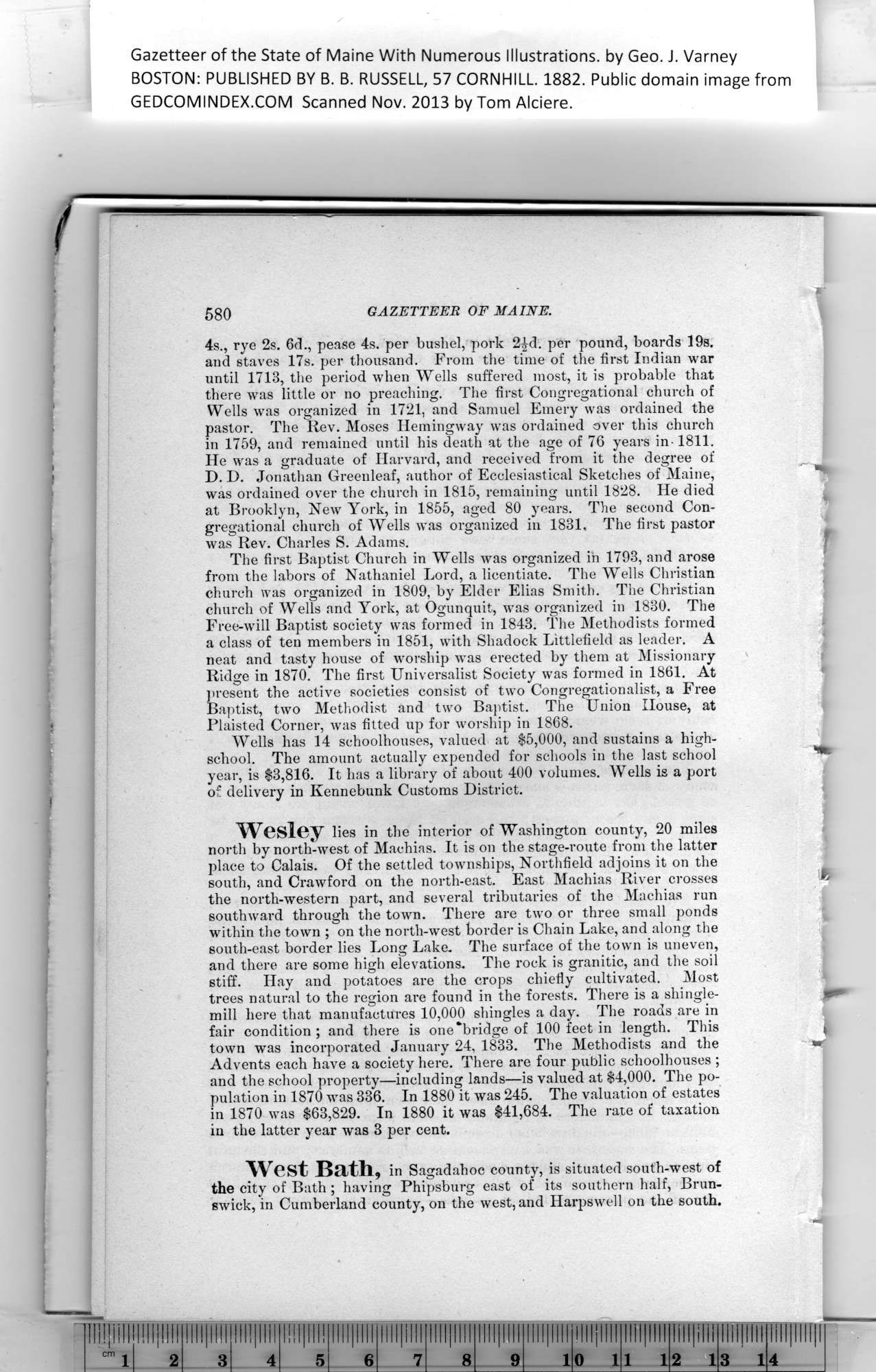|
Gazetteer of the State of Maine With Numerous Illustrations, by Geo. J. Varney
BOSTON: PUBLISHED BY B. B. RUSSELL, 57 CORNHILL. 1882. Public domain image from
580 GAZETTEER OF MAINE.
4s., rye 2s. 6d., pease 4s. per bushel, pork 2£d. per pound, boards 19s.
and staves 17s. per thousand. From the time of the first Indian war
until 1713, the period when Wells suffered most, it is probable that
there was little or no preaching. The first Congregational church of
Wells was organized in 1721, and Samuel Emery was ordained the
pastor. The Rev. Moses Hemingway was ordained over this church
in 1759, and remained until his death at the age of 76 years in-1811.
He was a graduate of Harvard, and received from it the degree of
D. D. Jonathan Greenleaf, author of Ecclesiastical Sketches of Maine,
was ordained over the church in 1815, remaining until 1828. He died
at Brooklyn, New York, in 1855, aged 80 years. The second Con-
gregational church of Wells was organized in 1831. The first pastor
was Rev. Charles S. Adams.
The first Baptist Church in Wells was organized in 1793, and arose
from the labors of Nathaniel Lord, a licentiate. The Wells Christian
church was organized in 1809, by Elder Elias Smith. The Christian
church of Wells and York, at Ogunquit, was organized in 1830. The
Free-will Baptist society was formed in 1843. The Methodists formed
a class of ten members in 1851, with Shadock Littlefield as leader. A
neat and tasty house of worship was erected by them at Missionary
Ridge in 1870. The first Universalist Society was formed in 1861. At
present the active societies consist of two Congregationalist, a Free
Baptist, two Methodist and two Baptist. The Union House, at
Plaisted Corner, was fitted up for worship in 1868.
Wells has 14 schoolhouses, valued at $5,000, and sustains a high-
school. The amount actually expended for schools in the last school
year, is $3,816. It has a library of about 400 volumes. Wells is a port
of delivery in Kennebunk Customs District.
Wesley lies in the interior of Washington county, 20 miles
north by north-west of Machias. It is on the stage-route from the latter
place to Calais. Of the settled townships, Northfield adjoins it on the
south, and Crawford on the north-east. East Machias River crosses
the north-western jiart, and several tributaries of the Machias run
southward through the town. There are two or three small ponds
within the town ; on the north-west border is Chain Lake, and along the
south-east border lies Long Lake. The surface of the town is uneven,
and there are some high elevations. The rock is granitic, and the soil
stiff. Hay and potatoes are the crops chiefly cultivated. Most
trees natural to the region are found in the forests. There is a shingle-
mill here that manufactures 10,000 shingles a day. The roads are in
fair condition; and there is one‘bridge of 100 feet in length. This
town was incorporated January 24, 1833. The Methodists and the
Advents each have a society here. There are four public schoolhouses ;
and tbe school property—including lands—is valued at $4,000. The po-
pulation in 1870 was 336. In 1880 it was 245. The valuation of estates
in 1870 was $63,829. In 1880 it was $41,684. The rate of taxation
in the latter year was 3 per cent.
West Bath, in Sagadahoc county, is situated south-west of
the city of Bath ; having Phipsburg east of its southern half, Brun-
swick, in Cumberland county, on the west, and Harpswell on the south.
PREVIOUS PAGE ... NEXT PAGE
This page was written in HTML using a program written in Python 3.2
|
